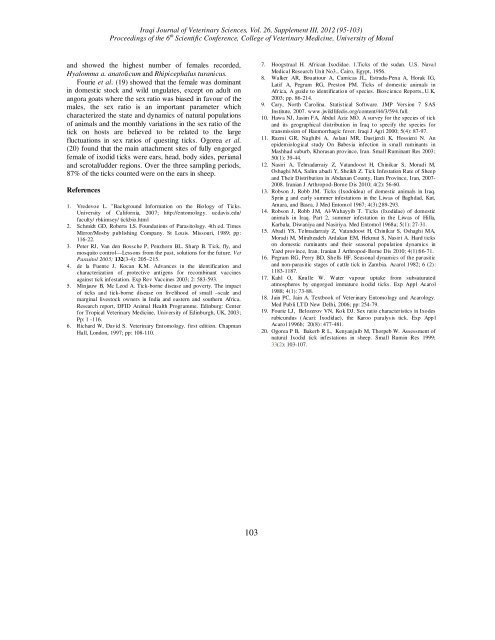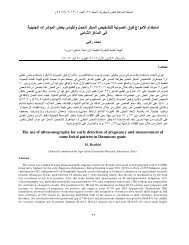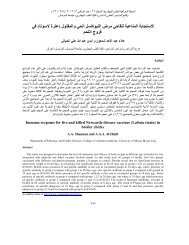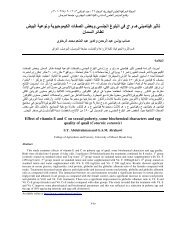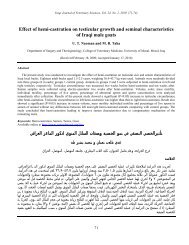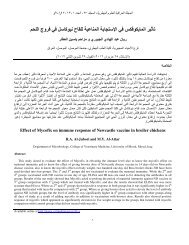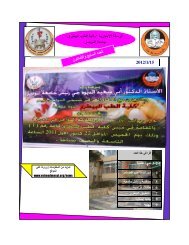fulltext (pdf) - College of Veterinary Medicine, University of Mosul, Iraq
fulltext (pdf) - College of Veterinary Medicine, University of Mosul, Iraq
fulltext (pdf) - College of Veterinary Medicine, University of Mosul, Iraq
Create successful ePaper yourself
Turn your PDF publications into a flip-book with our unique Google optimized e-Paper software.
<strong>Iraq</strong>i Journal <strong>of</strong> <strong>Veterinary</strong> Sciences, Vol. 26, Supplement III, 2012 (95-103)<br />
Proceedings <strong>of</strong> the 6 th Scientific Conference, <strong>College</strong> <strong>of</strong> <strong>Veterinary</strong> <strong>Medicine</strong>, <strong>University</strong> <strong>of</strong> <strong>Mosul</strong><br />
and showed the highest number <strong>of</strong> females recorded,<br />
Hyalomma a. anatolicum and Rhipicephalus turanicus.<br />
Fourie et al. (19) showed that the female was dominant<br />
in domestic stock and wild ungulates, except on adult on<br />
angora goats where the sex ratio was biased in favour <strong>of</strong> the<br />
males, the sex ratio is an important parameter which<br />
characterized the state and dynamics <strong>of</strong> natural populations<br />
<strong>of</strong> animals and the monthly variations in the sex ratio <strong>of</strong> the<br />
tick on hosts are believed to be related to the large<br />
fluctuations in sex ratios <strong>of</strong> questing ticks. Ogorea et al.<br />
(20) found that the main attachment sites <strong>of</strong> fully engorged<br />
female <strong>of</strong> ixodid ticks were ears, head, body sides, perianal<br />
and scrotal/udder regions. Over the three sampling periods,<br />
87% <strong>of</strong> the ticks counted were on the ears in sheep.<br />
References<br />
1. Vredevoe L. "Background Information on the Biology <strong>of</strong> Ticks.<br />
<strong>University</strong> <strong>of</strong> California, 2007; http://entomology. ucdavis.edu/<br />
faculty/ rbkimsey/ tickbio.html<br />
2. Schmidt GD, Roberts LS. Foundations <strong>of</strong> Parasitology. 4th ed. Times<br />
Mirror/Mosby publishing Company. St Louis. Missouri, 1989; pp :<br />
116-22.<br />
3. Peter RJ, Van den Bossche P, Penzhorn BL. Sharp B. Tick, fly, and<br />
mosquito control—Lessons from the past, solutions for the future. Vet<br />
Parasitol 2005; 132(3-4): 205–215.<br />
4. de la Fuente J, Kocan K.M. Advances in the identification and<br />
characterization <strong>of</strong> protective antigens for recombinant vaccines<br />
against tick infestation. Exp Rev Vaccines 2003; 2: 583-593.<br />
5. Minjauw B, Mc Leod A. Tick-borne disease and poverty. The impact<br />
<strong>of</strong> ticks and tick-borne disease on livelihood <strong>of</strong> small –scale and<br />
marginal livestock owners in India and eastern and southern Africa.<br />
Research report, DFID Animal Health Programme. Edinburg: Center<br />
for Tropical <strong>Veterinary</strong> <strong>Medicine</strong>, <strong>University</strong> <strong>of</strong> Edinburgh, UK, 2003;<br />
Pp: 1 -116.<br />
6. Richard W, David S. <strong>Veterinary</strong> Entomology. first edition. Chapman<br />
Hall, London, 1997; pp: 108-110.<br />
7. Hoogstraal H. African Ixodidae. 1.Ticks <strong>of</strong> the sudan. U.S. Nava l<br />
Medical Research Unit No3., Cairo, Egypt, 1956.<br />
8. Walker AR, Bouattour A, Camicas JL, Estrada-Pena A, Horak IG,<br />
Latif A, Pegram RG, Preston PM. Ticks <strong>of</strong> domestic animals in<br />
Africa, A guide to identification <strong>of</strong> species. Bioscience Reports,.U.K,<br />
2003; pp. 86-214.<br />
9. Cary, North Carolina. Statistical S<strong>of</strong>tware. JMP Version 7 SAS<br />
Institute, 2007. www.jwildlifedis.org/content/44/3/594.full.<br />
10. Hawa NJ, Jasim FA, Abdul Aziz MO. A survey for the species <strong>of</strong> tick<br />
and its geographical distribution in <strong>Iraq</strong> to specify the species for<br />
transmission <strong>of</strong> Haemorrhagic fever. <strong>Iraq</strong>i J Agri 2000; 5(4): 87-97.<br />
11. Razmi GR, Naghibi A, Aslani MR, Dastjerdi K, Hossieni N. An<br />
epidemiological study On Babesia infection in small ruminants in<br />
Mashhad suburb, Khorasan province, Iran. Small Ruminant Res 2003;<br />
50(1): 39-44.<br />
12. Nasiri A, Telmadarraiy Z, Vatandoost H, Chinikar S, Moradi M,<br />
Oshaghi MA, Salim abadi Y, Sheikh Z. Tick Infestation Rate <strong>of</strong> Sheep<br />
and Their Distribution in Abdanan County, Ilam Province, Iran, 2007-<br />
2008. Iranian J Arthropod-Borne Dis 2010; 4(2): 56-60.<br />
13. Robson J, Robb JM. Ticks (Ixodoidea) <strong>of</strong> domestic animals in <strong>Iraq</strong>.<br />
Sprin g and early summer infestations in the Liwas <strong>of</strong> Baghdad, Kut,<br />
Amara, and Basra. J Med Entomol 1967; 4(3):289-293.<br />
14. Robson J, Robb JM, Al-Wahayyib T. Ticks (Ixodidae) <strong>of</strong> domestic<br />
animals in <strong>Iraq</strong>. Part 2, summer infestation in the Liwas <strong>of</strong> Hilla,<br />
Karbala, Diwaniya and Nasiriya. Med Entomol 1968a; 5(1): 27-31.<br />
15. Abadi YS, Telmadarraiy Z, Vatandoost H, Chinikar S, Oshaghi MA,<br />
Moradi M, Mirabzadeh Ardakan EM, Hekmat S, Nasiri A. Hard ticks<br />
on domestic ruminants and their seasonal population dynamics in<br />
Yazd province, Iran. Iranian J Arthropod-Borne Dis 2010; 4(1):66-71.<br />
16. Pegram RG, Perry BD, Shells HF. Seasonal dynamics <strong>of</strong> the parasitic<br />
and non-parasitic stages <strong>of</strong> cattle tick in Zambia. Acarol 1982; 6 (2):<br />
1183-1187.<br />
17. Kahl O, Knulle W. Water vapour uptake from subsaturated<br />
atmospheres by engorged immature ixodid ticks. Exp Appl Acarol<br />
1988; 4(1): 73-88.<br />
18. Jain PC, Jain A. Textbook <strong>of</strong> <strong>Veterinary</strong> Entomology and Acarology.<br />
Med Publi LTD New Delhi, 2006; pp: 254-79.<br />
19. Fourie LJ, Belozerov VN, Kok DJ. Sex ratio characteristics in Ixodes<br />
rubicundus (Acari: Ixodidae), the Karoo paralysis tick. Exp App l<br />
Acarol 1996b; 20(8): 477-481.<br />
20. Ogorea P B, Bakerb R L, Kenyanjuib M, Thorpeb W. Assessment <strong>of</strong><br />
natural Ixodid tick infestations in sheep. Small Rumin Res 1999;<br />
33(2): 103-107.<br />
103


